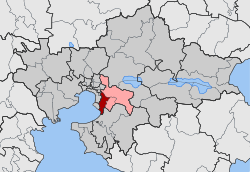Pylaia
| Pylaia Πυλαία | |
|---|---|
 Pylaia | |
|
Location within the regional unit  | |
| Coordinates: 40°36′N 22°59′E / 40.600°N 22.983°ECoordinates: 40°36′N 22°59′E / 40.600°N 22.983°E | |
| Country | Greece |
| Administrative region | Central Macedonia |
| Regional unit | Thessaloniki |
| Municipality | Pylaia-Chortiatis |
| • Municipal unit | 24.379 km2 (9.413 sq mi) |
| Population (2011)[1] | |
| • Municipal unit | 34,625 |
| • Municipal unit density | 1,400/km2 (3,700/sq mi) |
| Time zone | EET (UTC+2) |
| • Summer (DST) | EEST (UTC+3) |
Pylaia (Greek: Πυλαία) is a municipality of the Thessaloniki Urban Area and a former municipality in the regional unit of Thessaloniki, Greece. Since the 2011 local government reform it is part of the municipality Pylaia-Chortiatis, of which it is a municipal unit.[2] Pylaia covers 24.379 km2[3] with 4,5 km of coastline extending along the shores of the Thermaic Gulf and had a population of 34,625 inhabitants at the 2011 census. Pylaia is relatively sparsely populated for a municipality within the Thessaloniki Urban Area.
History
The first reference to Pylaia is found in the historian Thucydides, in 319 BC, under the name Strepsa. It was later known as Kapoutzida, from the Turkish word kapıcı ("gatekeeper"), deriving from the guards watching over the city walls of Byzantine Thessaloniki. The current name came into general use in 1927, and is derived from the word Pyle (πυλη), meaning gateway and referring to the Eastern Entrance of the city.
Notable residents
- Paschalis Terzis, singer
Communities
External links
- Official website (Greek)
References
- ↑ "Απογραφή Πληθυσμού - Κατοικιών 2011. ΜΟΝΙΜΟΣ Πληθυσμός" (in Greek). Hellenic Statistical Authority.
- ↑ Kallikratis law Greece Ministry of Interior (Greek)
- ↑ "Population & housing census 2001 (incl. area and average elevation)" (PDF) (in Greek). National Statistical Service of Greece.